Generally speaking, instrument backs are made of maple. And most of the time, they are either in one piece, or in two pieces with a joint down the middle. Maple was used from the earliest days of violin making because of its superb acoustic properties … and also because it’s pretty. The distinctive stripes that run across the back are called ‘flame’ or ‘curl’ or ‘figure’ (in Italian, ‘marezzatura’; in German, ‘flammen’; in French, ‘onde’).
When a violinmaker sets out to make a violin, he or she has certain choices to make (some of these are conscious decisions, others are subconscious and determined by instinct). Will the back be in one piece or two? If it’s a one-piece back, will the flame go up from left to right or down? If it’s a two piece back, will the halves be joined as a ‘bookmatch’ and will the flame ascend from the center-joint or go down? Often these choices are dictated by woodstock – is the wood wide enough to make a one-piece back? Are there knots or flaws that need to be avoided? – but apart from material limitations, the layout of the back of an instrument is really up to the maker’s preferences and predisposition.
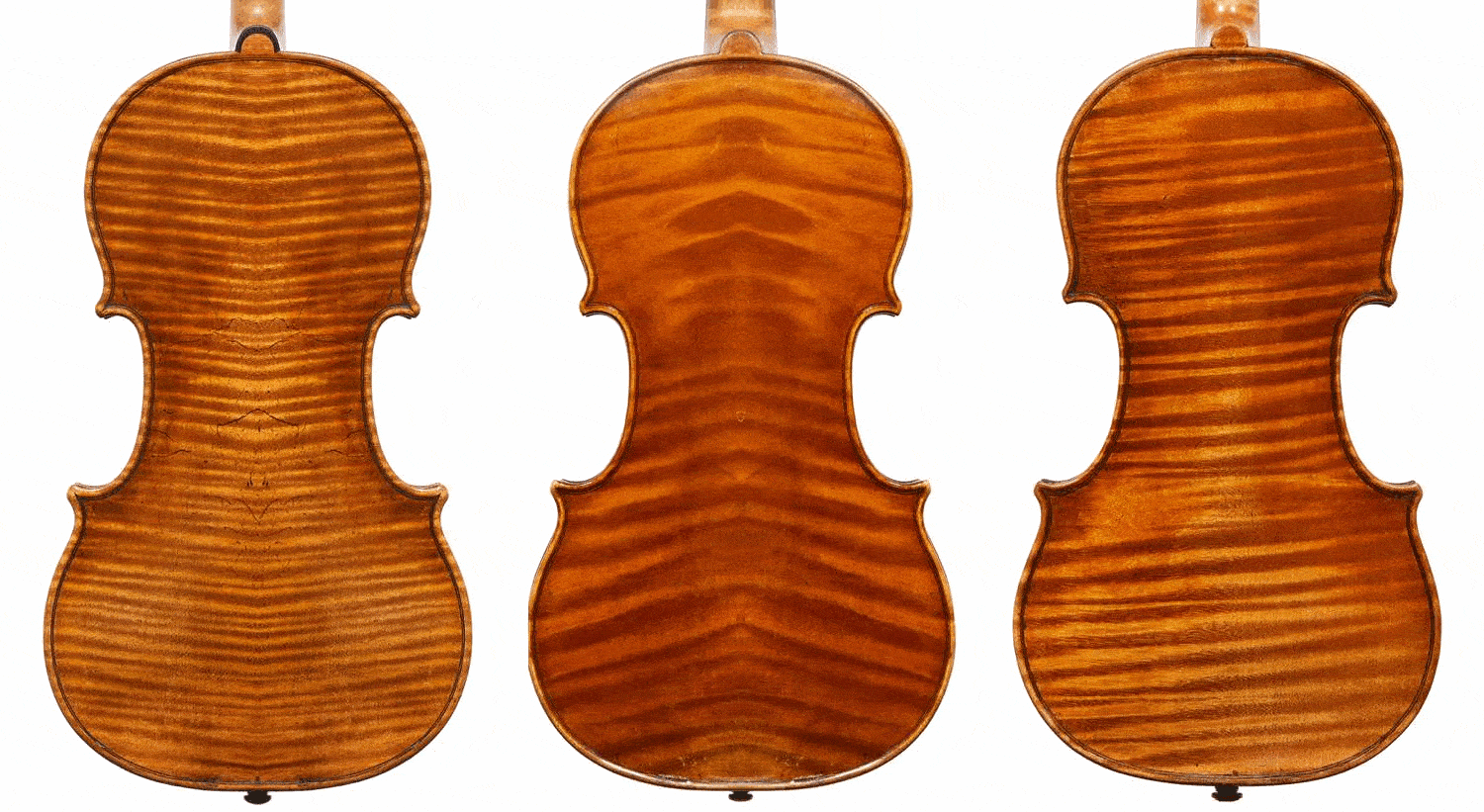
From our vantage point, many centuries after these instruments were made, it’s almost impossible to know what choices were deliberate and which were arbitrary. We can, however, study the body of work that each maker has left us with the hope of detecting the subtle preferences and tendencies of their making style. How on earth would we do that? There’s this little thing called The Cozio Archive…
If you’ve been following our Carteggio essays for the past few years you know that we have invested heavily in tools to organize and index the data in the archive. Our collaborators wrote a suite of imaging software that can determine the parts of a violin and identify an instrument if it finds a match in the archive. One of the byproducts of their work was that we now have a full index of the back of every instrument in the Cozio Archive: Is it made in one-piece or two? Does the flame go up or down? You see where this is going.
The back in one piece of maple…
Here’s a good place to start: Which makers preferred one-piece backs and which preferred two? Before looking at the data, I had a few examples in my head of makers that were more likely to make instruments with one-piece backs: Pressenda and Oddone, two Titans of the Piemontese school. Was I right?
| Maker | % one-piece backs |
| Didier Nicolas l’aîné | 96.30% |
| Jacques-Pierre Thibout | 95.20% |
| Giorgio Gatti | 91.70% |
| Pierre Pacherele | 91.70% |
| Giovanni Francesco Pressenda | 91.70% |
| Honoré (Jean-Joseph) Derazey | 88.70% |
| Charles François Gand père | 88.60% |
| Jean-François Aldric | 87.50% |
| Gand Frères Firm | 87% |
| Alessandro Gagliano | 83.60% |
| Georges Chanot II | 82.60% |
| François-Louis Pique | 81.80% |
| Pierre & Hippolyte Silvestre | 80% |
| Georges Chanot I | 79.70% |
| Spirito Sorsana | 79.20% |
| Jules Joseph Grandjon | 78.60% |
| Pierre Silvestre | 78.60% |
| Nicolas Lupot | 78.40% |
| Emile Mennesson | 73.90% |
| Carlo Giuseppe Oddone | 72.90% |
| Alessandro D’Espine | 72.50% |
| Auguste Sébastien Philippe Bernardel père | 71% |
| John Betts I | 70.80% |
| Claude Augustin Miremont | 66.70% |
| George Wulme-Hudson | 65.20% |
| Giuseppe Antonio Rocca | 65.20% |
| Charles Adolphe Gand | 65% |
| Annibale Fagnola | 63.20% |
| Carlo Bergonzi I | 62.10% |
| Giovanni Pistucci | 61.90% |
| Gand & Bernardel Firm | 61.80% |
The top thirty makers with the greatest percent of instruments with a one-piece back.
(I have excluded makers with fewer than 20 instruments in the archive.)
-
-
- Correct: Pressenda made 91.7% of his instruments with a one-piece back and Oddone made 72.9% of his. Meaning, Pressenda was more than nine times as likely to make an instrument with a one-piece back, and Oddone was almost three times as likely.
- Another interesting trend emerged: twenty-five of the thirty makers who preferred one-piece backs were either French or Piemontese. Gatti, Pressenda, Rocca, D’Espine and Sorsana all strongly preferred one-piece backs, as did Derazey, Gand, Pique, Bernardel, Silvestre, and many other French makers of the 19th century.
- It’s worth noting that cellos are included in the tallies above. As cello backs require a larger piece of maple, there are generally fewer cellos with one-piece backs than violins. I didn’t dive too deeply into this but a quick query shows cellos are 12.5 times more likely to be made with a two-piece back than one.
- Conspicuously absent from this table are most classical makers. But we’ll get into that later.
-
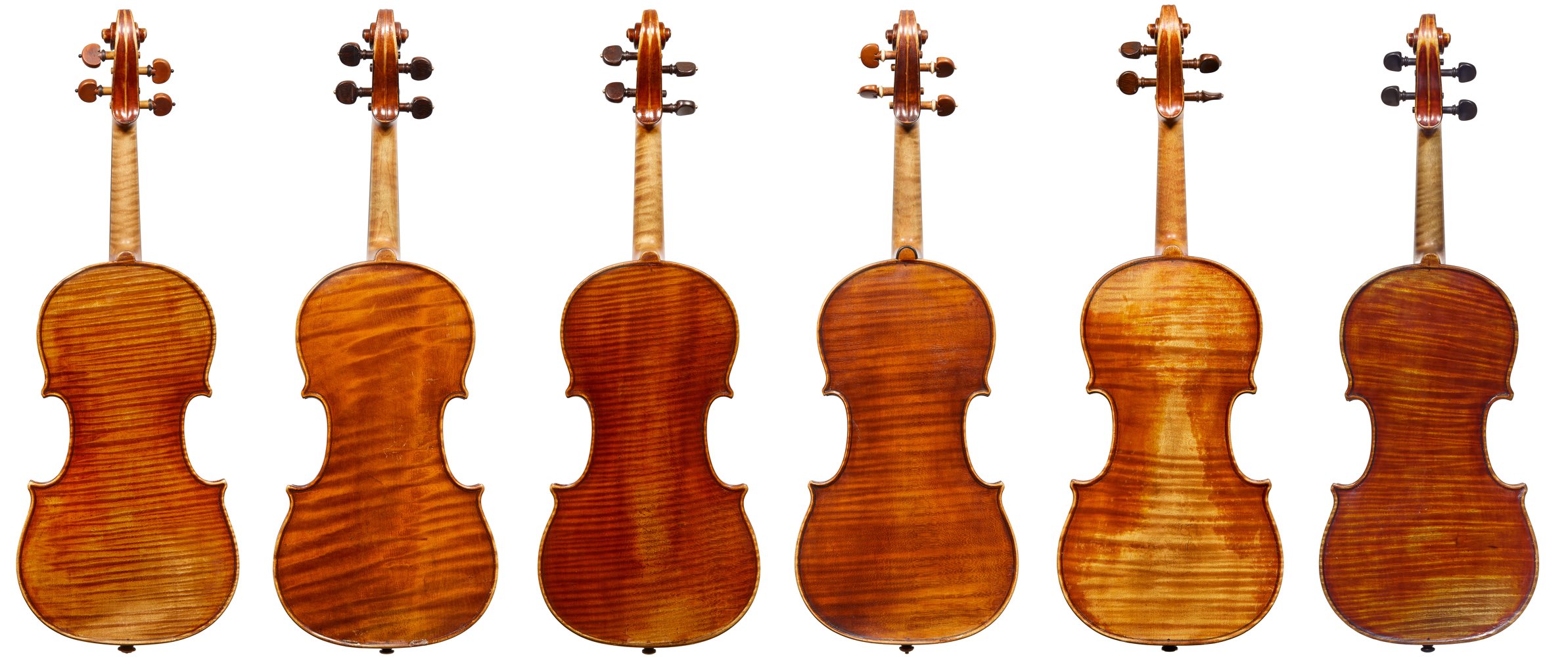
Instruments by Giovanni Francesco Pressenda are nine times more likely to have a back in one piece than two.
The back in two pieces…
Analyzing the opposite of this – which makers preferred two-piece backs – is also revealing:
| Maker | % two-piece backs |
| Giuseppe Tarasconi | 95.70% |
| Eugenio Degani | 94.30% |
| Carlo Giuseppe Testore | 92.30% |
| Celestino Farotto | 90.60% |
| Giuseppe Gagliano | 89% |
| Enrico Clodoveo Melegari | 88.90% |
| Pietro Giovanni Mantegazza | 88.50% |
| Stefano Scarampella | 88.50% |
| David Tecchler | 88.30% |
| Andrea Castagneri | 87% |
| Gasparo Bertolotti ‘da Salò’ | 85.70% |
| Giulio Ettore Degani | 84.60% |
| Giovanni Guidanti | 84.40% |
| Antonio Gragnani | 84.10% |
| Giovanni Battista Gabrielli | 83.90% |
| François Caussin | 83.30% |
| Umberto Lanaro | 82.10% |
| Igino Sderci | 82.10% |
| George Gemünder I | 81.80% |
| Gaetano Gadda | 81.70% |
| Paolo Castello | 81% |
| Vincenzo Postiglione II | 80.10% |
| Joseph Panormo | 80% |
| Riccardo Antoniazzi | 80% |
| Tomaso Eberle | 78.30% |
| Marc André Joseph Laberte | 78% |
| Giacomo & Leandro Bisiach | 77.80% |
| Léon Victor Mougenot | 77.80% |
| Marino Capicchioni | 77.40% |
| Carlo Antonio Testore | 77.40% |
The top thirty makers with the greatest percent of instruments with a two-piece back.
(Again, I excluded makers with fewer than 20 instruments in the archive.)
-
-
- From observation and experience, I would have supposed that the Mantua makers, Stefano Scarampella and Gaetano Gadda were more likely to make instruments with two-piece backs. And again, the data confirm this: Scarampella made almost nine times as many backs in two-pieces as he did in one (88.5%), and Gadda made just over four times as many two-piece backs (81.7%).
- I was also surprised to see the strong preferences of the early 20th century Bisiach school makers: Bisiach, Riccardo Antoniazzi, Sderci, Farotto and Tarasconi all favored two-piece backs.
- If we examine the data for makers that made exclusively backs in two pieces, we can further confirm the conclusion about Bisiach school makers: Galimberti, Briani, Sironi and Erba are all represented exclusively by instruments with two-piece backs in the archive (I’m sure there are exceptions that I am not aware of).
- And several Mantua makers confirm our observation of the Scarampella/Gadda school: Simonazzi, Zobboli, Barbieri and Guastalla, are also exclusively represented with two-piece backs.
- The preference of Gaspar ‘da Salò’ (85.7% of backs made in two-pieces) was also surprising; but more on that later.
-
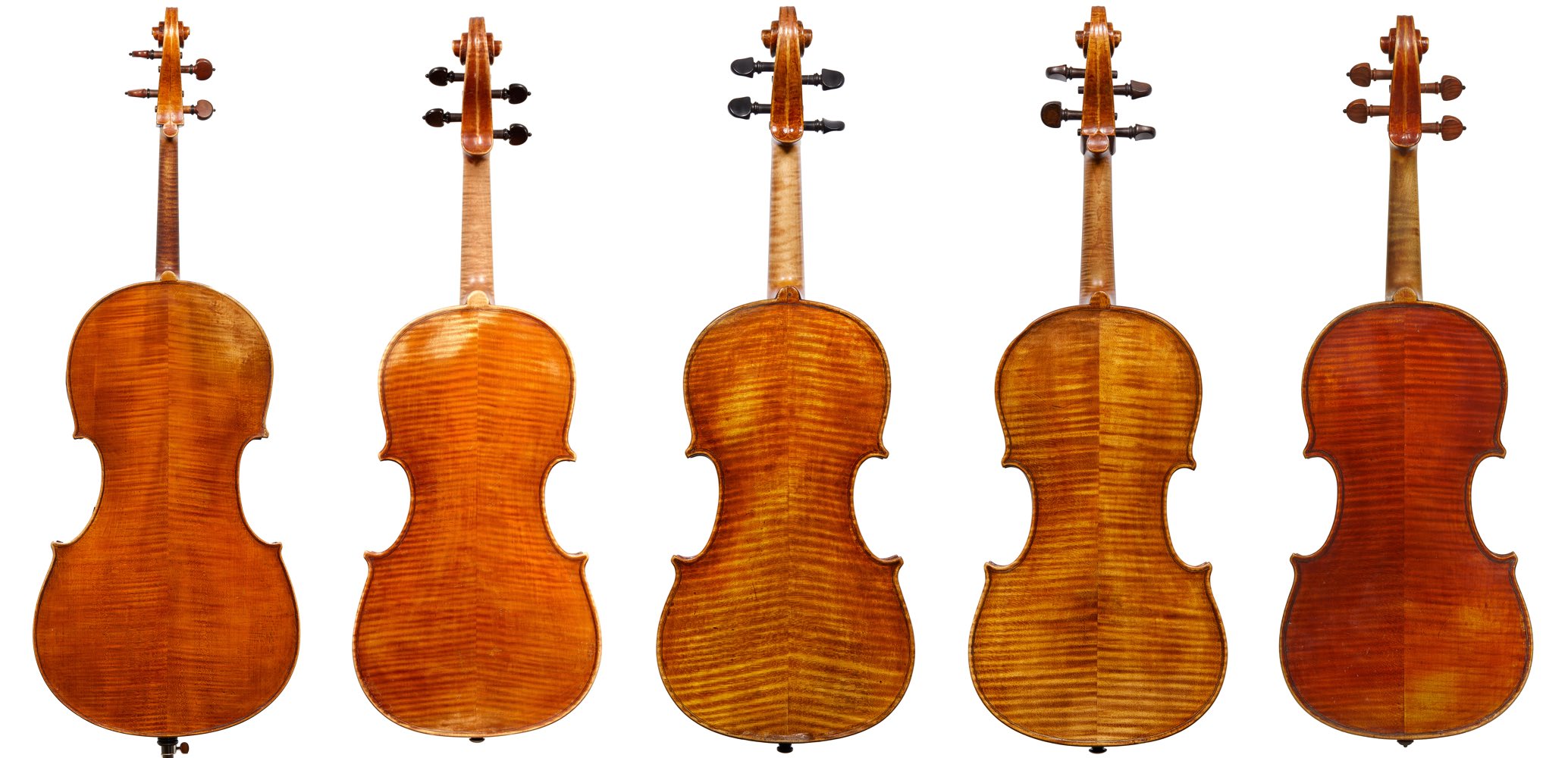
88.5% of instruments by Scarampella have a two piece back. The same preference holds for his students and others in the Scarampella/Mantua school, Gadda, Simonazzi, Zobboli, Barbieri and Guastalla.
With flame of medium width…
So far, we have only considered the question of one-piece vs two-piece backs and we haven’t yet considered the orientation of the figure across the back – does the flame go up or down relative to the geometric horizontal? As we’ll see below, historically there hasn’t been much preference for flame direction on one-piece backs – up to the left and up to the right were just about equally popular – but for two-piece backs the preference for flame orientation is easily observed in many makers.
To start, there are nine different orientations for flame on a two-piece back (ignoring the possibilities that the back is unfigured, indistinct or birdseye maple). I will illustrate the nine possibilities as follows:
— -/ -\ /- // /\ \- \/ \\
Descending from the center joint… (/\)
By far, the most common orientation of flame in two-piece backs is where the sides are book-matched and either ascend (\/) or descend (/\) from the center joint. Analyzing the data, we find makers with surprisingly strong preferences in this regard. The following table shows makers who preferred backs with flame descending from the center joint:
| Maker | Two-piece backs with flame descending |
| Charles Jean-Baptiste Collin-Mézin père | 100.00% |
| Gand & Bernardel Firm | 100.00% |
| Enrico Clodoveo Melegari | 96.88% |
| Gustave Adolphe Bernardel | 96.67% |
| Carl Becker Sr. | 93.55% |
| Giuseppe Pedrazzini | 93.15% |
| Mario Gadda | 92.31% |
| Gaetano Pollastri | 92.31% |
| Amédée Dieudonné | 91.53% |
| Paul Francois Blanchard | 91.43% |
| Charles Collin-Mézin fils | 91.30% |
| Jérôme Thibouville-Lamy Firm | 90.91% |
| Annibale Fagnola | 90.48% |
| Giacomo & Leandro Bisiach | 90.48% |
| Giuseppe Fiorini | 89.19% |
| Gaetano Gadda | 87.76% |
| Paul Bailly | 87.50% |
| Riccardo Genovese | 86.36% |
| Georges Apparut | 85.71% |
| Marino Capicchioni | 85.42% |
| Enrico Rocca | 84.62% |
| Marc André Joseph Laberte | 84.38% |
| Pierre Joseph Hel | 83.67% |
| Giulio Ettore Degani | 83.12% |
| Léon Victor Mougenot | 82.86% |
| Antonio Capela | 80.95% |
| Stefano Scarampella | 80.00% |
| Ansaldo Poggi | 79.49% |
| Giuseppe Ornati | 79.41% |
The top thirty makers with a preference for two-piece backs descending from the center joint.
(Again, I have excluded makers with fewer than 20 instruments in the archive.)
-
-
- First off, I find it incredible that 100% of the instruments in the archive by Collin-Mezin have flame descending from the centre-joint (and 91.3% of those by his son). That is a remarkable conclusion, given how prolific this family of makers was. (I’m sure there are exceptions that I don’t know of and I look forward to people pointing them out!)
- 100% of the two-piece back instruments of the Gand & Bernardel firm in the archive were also made with descending flame as were 96.7% of those made individually by the firm’s partner, Gustave Bernardel.
- The two-piece backs of Carl Becker Sr. are highly likely to have descending flame (93.6%). There are only six two-piece backs by his son, Carl Jr., in the archive but 83.33% of those are also with descending flame.
- We noted earlier that the instruments of the Scaramella school were more commonly found with two-piece backs (88.5% of Scarampella instruments in the archive have a two-piece back). This new table confirms that of those two-piece backs, the overwhelming majority are made with flame descending from the center joint (80.0% of Scarampellas with two-piece backs have descending flame, as do 87.8% of Gaetano Gadda’s and 92.3% of Mario Gadda’s).
- Giuseppe Fiorini and his student Ansaldo Poggi both preferred flame descending from the joint (nine out of ten Fiorini’s and four out of five Poggi’s are oriented this way).
- Pollastri, Fagnola, Capicchioni and Ornati also strongly preferred descending flame.
-
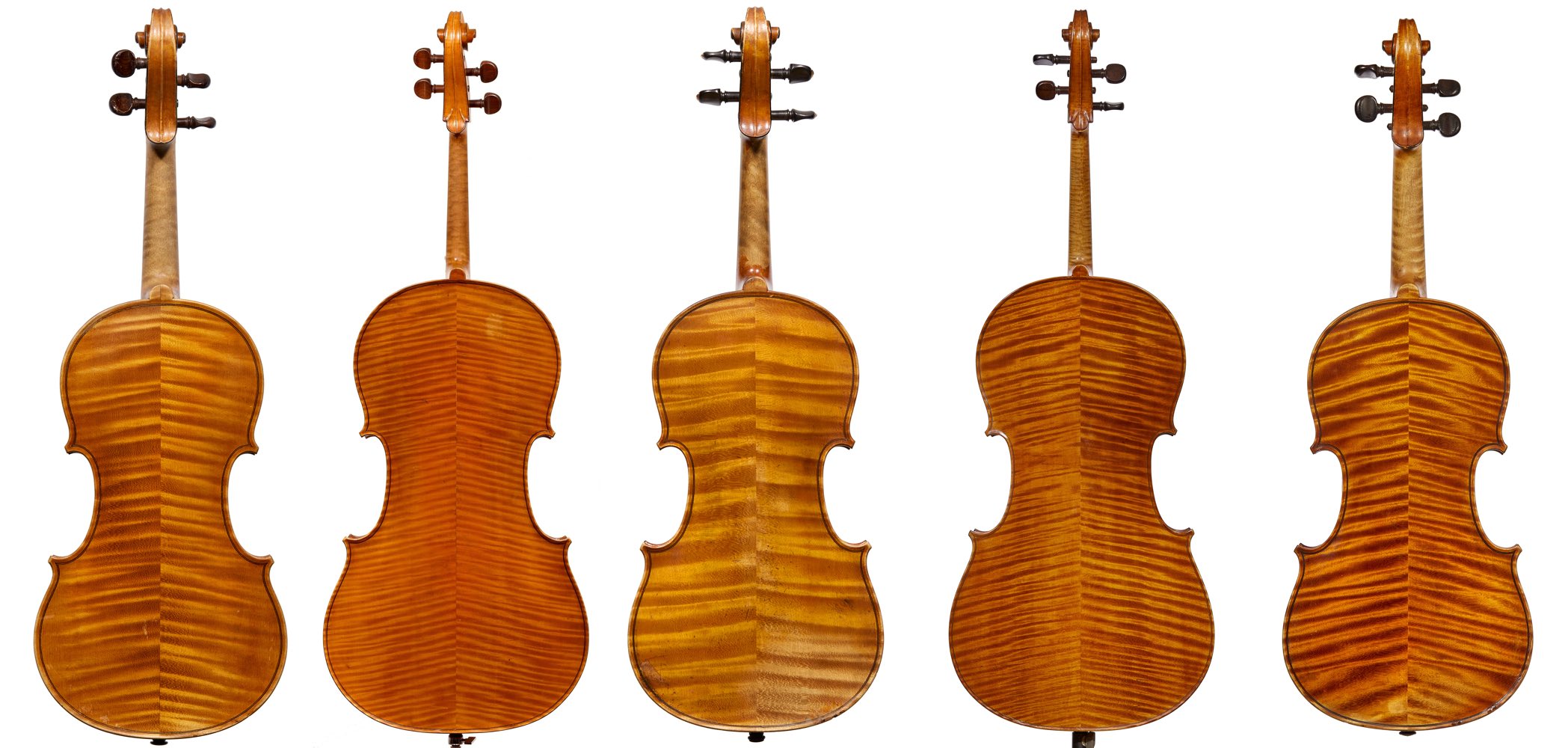
There are 107 instruments by Jean Baptistie Collin-Mezin in the Cozio archive that have a two piece back. All of them have flame descending from the center joint.
Ascending from the center joint… (\/)
Next, I examined data for instruments with flame ascending from the center joint and here’s where things got very interesting. There are no makers with strong preferences for flame ascending from the center joint. Plenty of makers used this orientation from time to time, but no maker of any sizable output of instruments favored this configuration consistently. Here is the data:
| Maker | Two-piece backs with flame ascending |
| George Gemünder I | 59.26% |
| Michele Deconet | 53.33% |
| Giovanni Battista Gabrielli | 51.92% |
| Pietro Guarneri of Mantua | 46.43% |
| Bernardo Calcagno | 44.44% |
| Pietro Giovanni Mantegazza | 43.48% |
| Antonio Gragnani | 43.10% |
| Camillo Camilli | 42.86% |
| Giuseppe Guarneri ‘filius Andreae’ | 42.31% |
| Jean-Baptiste Vuillaume | 42.04% |
| Carlo Bergonzi I | 40.91% |
| Pietro Guarneri of Venice | 40.00% |
| Andrea Castagneri | 40.00% |
| Tommaso Balestrieri | 38.46% |
| Giuseppe & Antonio Gagliano | 38.46% |
| Giovanni Battista Guadagnini | 37.22% |
| Giovanni Guidanti | 37.04% |
| Giovanni Paolo Maggini | 36.36% |
| Carlo Ferdinando Landolfi | 34.55% |
| Francesco Rugeri | 34.15% |
| Matteo Goffriller | 33.93% |
| Giuseppe Gagliano | 33.85% |
| Santo Serafin | 33.33% |
| Jacob Stainer | 32.08% |
| Eugenio Degani | 31.71% |
| Girolamo Amati II | 30.77% |
| Bartolomeo Giuseppe Guarneri ‘del Gesù’ | 30.67% |
| Domenico Montagnana | 30.23% |
| Carlo Antonio Testore | 29.17% |
| Nicolò Gagliano | 28.77% |
-
-
- We saw in an earlier table that George Gemünder preferred two piece backs (81.80% preference). In the table above, we see that Gemünder had the highest incidence of flame ascending from the center-joint at 59.3%.
- It’s also striking to see that there are only three makers, whose output of two-piece backs favored ascending flame more than 50% of the time. (Remember that ascending and descending aren’t the only possibilities, we will discuss –, -/, -\, /-, //, \- and \\ shortly).
- Compared to the previous table, it’s remarkable that there are no makers who strongly preferred flame ascending from the center joint and yet there were dozens of makers who strongly preferred flame that descended. (Remember, I removed makers with fewer than twenty examples of two-piece backs, but still, the general preference for descending flame is clear and unmistakable).
- I find it astonishing that 59.3% is the strongest preference for ascending flame of all the Cozio data. 59.3% could be characterized as a predisposition, but one could hardly describe it as a strong preference. The Cozio archive tracks XXX makers. How is it possible that no single maker of any significant output made ascending flame his thing?
-
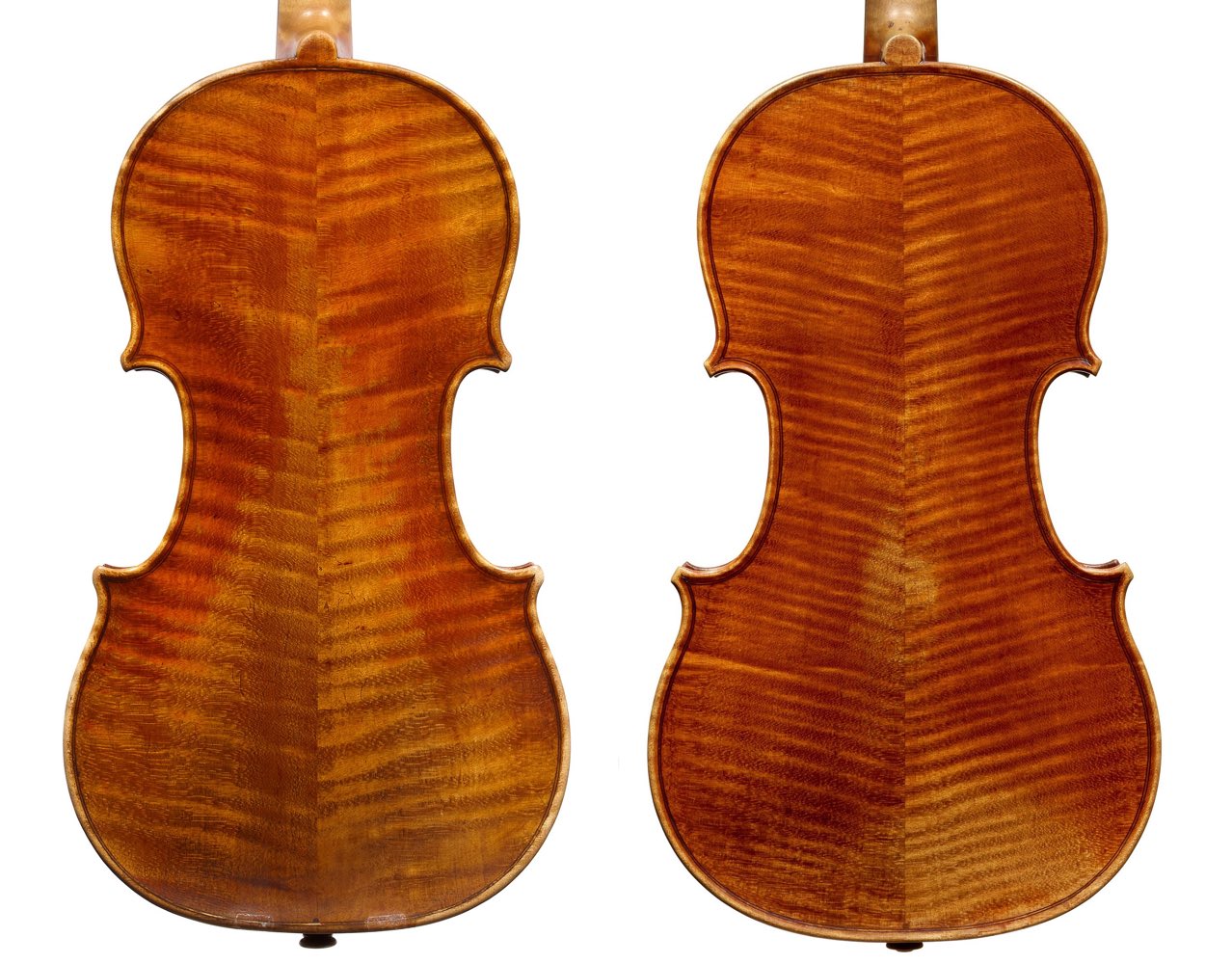
Only 20% of Stradivari’s two-piece backs have flame ascending from the center joint (10.5% of his total instruments). But among those are some of his finest instruments, like the ‘Soil’ and the ‘Lady Blunt’ illustrated above.
The back in one piece or two, with flame ascending, descending or mostly horizontal…
Now seems like a good time to give some percentages of the total composition of instruments in the archive. Of the total instruments indexed on the public archives accessible on Cozio, 41.3% have a one-piece back compared to 58.7% with a two-piece back. (For convenience, we ignored a handful of instruments whose backs were indeterminate or made up of three, four and multiple pieces). It’s also important to mention that these data include basses and cellos which are less likely to be made in one piece than violins and violas.
The orientation of flame across all instruments in the archive is as follows:
| Flame orientation | % of total instruments | % of two-piece backs |
| – | 4.34% | |
| / | 18.19% | |
| \ | 18.75% | |
| — | 1.05% | 1.79% |
| -/ | 0.76% | 1.30% |
| -\ | 1.15% | 1.95% |
| /- | 1.18% | 2.02% |
| // | 1.39% | 2.38% |
| /\ | 38.94% | 66.33% |
| \- | 0.71% | 1.21% |
| \/ | 12.32% | 20.99% |
| \\ | 1.20% | 2.04% |
Flame configuration by percentage of instruments in the Cozio archive.
A few comments:
-
-
- This corroborates my earlier observation that, on a whole, makers strongly prefer two piece backs with flame descending from the center joint. Or, put another way: there are three times as many two-piece backs in the archive with descending flame than ascending.
- Interestingly, I also notice that there is no preference for ascending or descending flame on one-piece backs. Each configuration weighs in at approximately 18.5% of the total. (Jean Gosselin and Pierre Pacherele were twice as likely to make one-piece backs with flame ascending from treble to bass and Jacques-Pierre Thibout and Mathias Heinicke were twice as likely to make one-piece backs with flame descending from treble to bass but those makers are outliers and there doesn’t seem to be any recognizable general preference with most makers.)
- The four “mismatched” configurations (-/, -\, /- and \-) each show up with a negligible prevalence of approximately 1% of the total instruments studied, which might be accounted for by the margin of software error.
- The two “parallel” orientations on two-piece backs, // and \\, also show up with an incidence at 1.4% and 1.2% apiece. This is worth a closer look, especially as regards the early classical makers who frequently used this configuration.
-
The back in two pieces of maple with flame ascending across the joint… (// or \\)
Let’s have a look at makers who had a high preference for // and \\ flame orientation:
| Maker | Two-piece back with // or \\ |
| Antonio & Girolamo Amati | 50.00% |
| Girolamo Amati II | 42.31% |
| Gioffredo Cappa | 28.21% |
| Giovanni Gagliano I | 19.05% |
| Giovanni Battista Grancino I | 18.60% |
| Carlo Antonio Testore | 16.67% |
| Nicolò Amati | 15.71% |
| Giovanni Paolo Maggini | 15.15% |
| Carlo Ferdinando Landolfi | 14.55% |
| Matteo Goffriller | 14.29% |
| Lorenzo Storioni | 13.51% |
| Jacob Stainer | 13.21% |
| Johannes Theodorus Cuypers | 13.21% |
| Francesco Rugeri | 12.20% |
| David Tecchler | 11.32% |
| Camillo Camilli | 10.71% |
| Andrea Guarneri | 10.29% |
| Lorenzo & Tomaso Carcassi | 10.00% |
| Giuseppe Guarneri ‘filius Andreae’ | 9.62% |
| Giovanni Battista Rogeri | 9.43% |
The twenty makers who most frequently preferred a // or \\ flame configuration.
(I eliminated makers who had fewer than 20 examples in the archive.)
-
-
- The first thing to observe here is that these are exclusively 16th, 17th and 18th century makers. This isn’t surprising; we know from experience that this flame configuration was very common with the early Cremonese makers and their followers, but it’s startling to see how thoroughly this orientation went out of style.
- The most prominent school of making in the above table are the Amati family and their disciples.
- I find it startling that 50% of the Brothers Amati production of two-piece backs are made with parallel flame.
- Andrea Guarneri and his son Giuseppe made approximately 10% of their two-piece backs this way. I know of three ‘del Gesu’ violins with this configuration. Interestingly, I don’t know of any Peter of Mantua instruments made this way but I hope someone can point one out to me.
- Rugeri, Rogeri, Cappa and Stainer are all (broadly speaking) of the Amati school and it’s not surprising to see their wood-choice preferences align.
- Some of the most prolific makers of the 19th and 20th century never used the // or \\ flame orientation. J. B. Vuillaume made over 3,000 instruments but none (that I know of) was made with a two-piece back with this orientation. Again, I hope someone will point one out for me!
- As we saw earlier, 2.6% of the total instruments in the archive were made with an orientation of // or \\ which doesn’t sound like a large number. However, 90.5% of all the makers in the Cozio database never made an instrument of either of these parallel orientations.
- There’s one other factor that might be skewing the data in the table above. As we know, many of the violas of the 16th and 17th centuries have since been reduced in size. Often this entailed removing a small section from the center. When you reduce a one-piece back down the middle, you end up with a two-piece back with parallel flame…
-

A full 50% of instruments by the Brothers Amati with two piece backs have “parallel flame.” The classical Amati school makers used this configuration of flame far more than any school of makers ever since.
Okay, landing now. That was fun, I hope you enjoyed.